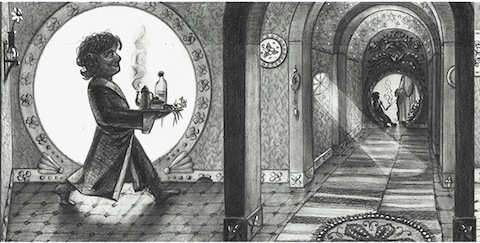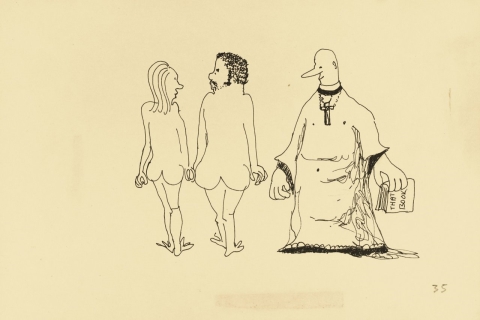
Upon his tragic early death at 40, John Lennon left behind a body of work few popular artists could hope to equal. And that’s only the published stuff. As we pointed out in a recent post on his home demos, the former Beatle also left hundreds of hours of tape recordings for his fans to sift through, and, as if that weren’t enough, Sotheby’s recently auctioned off a storehouse of original manuscripts and autographed drawings for two books Lennon wrote in the mid-sixties, In His Own Write (1964) and A Spaniard in the Works (1965), a Sherlock Holmes parody.
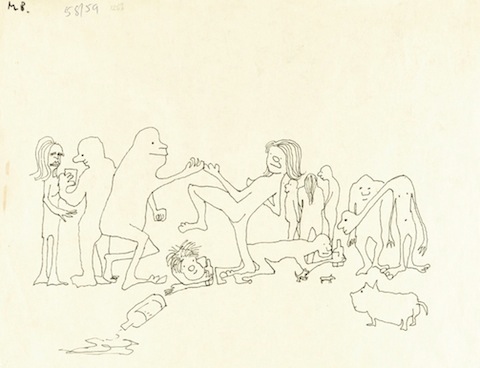
Lennon’s playful sense of humor and surreal imagination shine through the stories and poems in both books, as does his more moody broody side. If anything, Lennon’s wordplay and out-there line drawings closely resemble the work of Shel Silverstein, who was probably not an influence but certainly a kindred spirit. Sotheby’s specialist Gabriel Heaton cites as Lennon’s influence “the nonsense tradition of English literature,” and indeed Lewis Carroll comes to mind when reading his work. See, for example, “About The Awful,” his author’s statement for In His Own Write:
I was bored on the 9th of Octover 1940 when, I believe, the Nasties were still booming us led by Madolf Heatlump (who only had one). Anyway they didn’t get me. I attended to varicous schools in Liddypol. And still didn’t pass — much to my Aunties supplies. As a member of the most publified Beatles my (P, G, and R’s) records might seem funnier to some of you than this book, but as far as I’m conceived this correction of short writty is the most wonderfoul larf I’ve every ready.
God help and breed you all.
And then there’s the artwork. At the top, see an untitled ink drawing of a vicar leering at a nude couple (and holding in his hand “That Book”). The drawing above shows a clique of naked partiers, with the caption “Puffing and globbering they drugged theyselves rampling or dancing with wild abdomen, stubbing in wild postumes amonst themselves…”
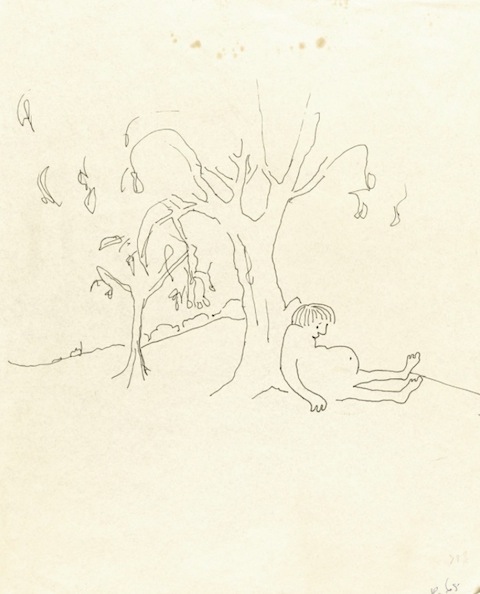
Recalling the artwork in Silverstein’s The Giving Tree, directly above we have a simple illustration for a poem called “I Sat Belonely,” captioned with the poem’s first two lines: “I Sat Belonely Down a Tree, Humbled Fat and Small” (read the full poem here).

Another Silversteinian drawing is titled “A Lot of Flies on His Wife” from a short story called “No Flies on Frank,” whose title character speaks in an argot right out of James Joyce: “I carn’t not believe this incredible fact of truth about my very body which has not gained fat since mother begat me at childburn. Yea, though I wart through the valet of thy shadowy hut I will feed no norman. What grate qualmsy hath taken me thus into such a fatty hardbuckle.”
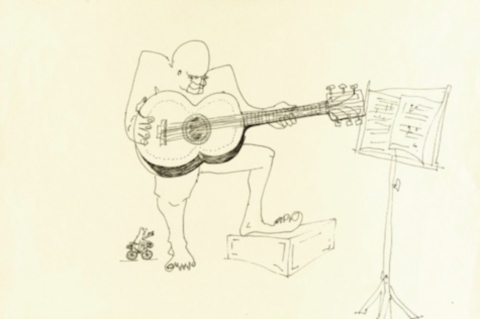
Just above, Lennon sketches a Picasso-like four-eyed guitarist in this untitled drawing (notice the tiny cyclist at his feet)—estimated by Sotheby’s between $15,000 and $25,000. The eighty nine lots that went up for auction included many other drawings (see more here) and some handwritten notes from Paul McCartney. All told, the sale netted close to $3 million, though for Lennon devotees, these artifacts are priceless. .
via The Daily Beast
Related Content:
John Lennon Plays Basketball with Miles Davis and Hangs Out with Allen Ginsberg & Friends
Josh Jones is a writer and musician based in Durham, NC. Follow him at @jdmagness.


